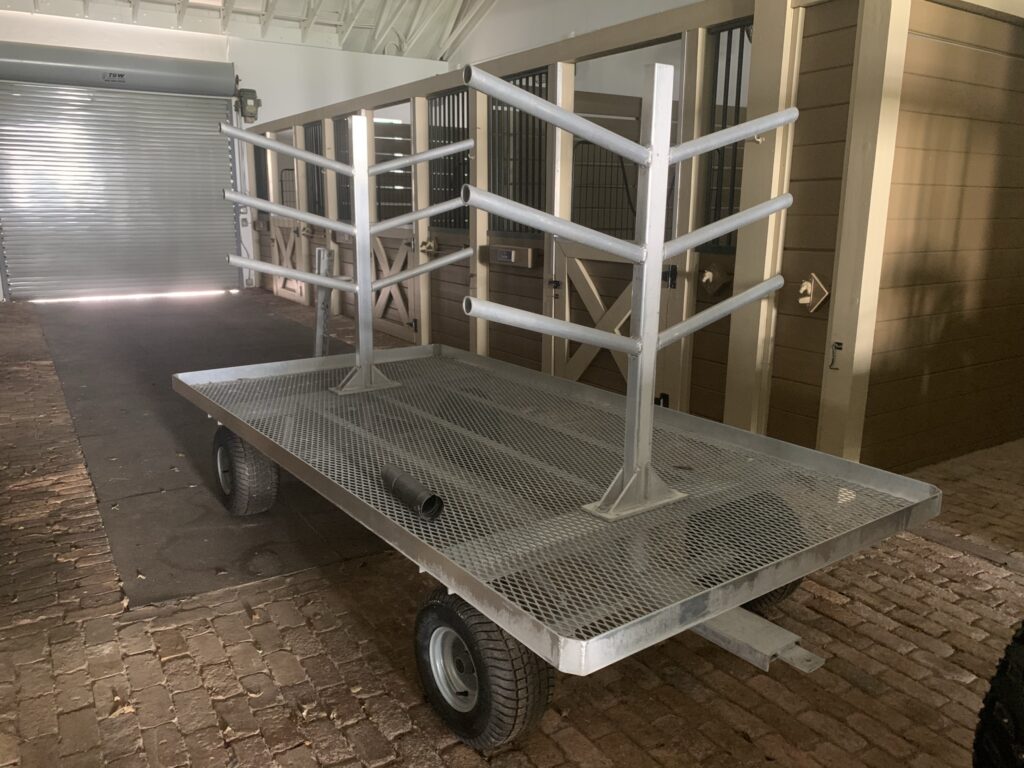Managing a horse facility efficiently requires the right equipment, and one of the most valuable assets is a set of well-suited trailers. From moving jumps and poles to handling farm materials such as hay, feed, and fencing, having the proper trailers ensures smooth operations, reduces labor, and enhances organization. This blog explores the key benefits of investing in the right trailers, along with considerations for sizing, materials, weight capacity, and specific trailer types for different needs.

The Essential Guide to Choosing the Right Trailers for Your Horse Facility
A horse facility constantly deals with heavy and bulky items, and using trailers designed for specific purposes can streamline daily operations. Here’s how trailers can make a difference:
- Efficient Transport: Whether you need to move jumping poles, standards, or bulkier items like hay and shavings, a trailer allows for easy and efficient transport across the facility.
- Proper Storage: Instead of leaving jumps and other equipment exposed to the elements, specialized trailers provide a structured storage solution.
- Labor and Time Savings: A well-equipped trailer reduces manual labor by allowing staff to move multiple items at once instead of making multiple trips.
- Preservation of Equipment: Keeping jumps, fencing, and farm materials on designated trailers prevents wear and tear from improper storage and exposure to harsh weather conditions.
Choosing the Right Trailer for the Job
When selecting trailers for a horse facility, it’s crucial to consider factors such as size, materials, weight capacity, and the type of equipment you’ll be transporting. Below is a breakdown of key considerations:
1. Size Considerations for Tight Spaces
- Horse facilities often have limited maneuvering space, especially around barns, arenas, and storage areas. Choosing compact trailers with good turning ability ensures smooth operation in narrow areas.
- For transporting jump poles and standards, jumping pole trailers like the JPT100 Jumping Pole Trailer offer a practical solution. These trailers are long enough to accommodate poles but are designed for easy navigation within the facility.
- Flatbed trailers are ideal for larger loads but should be chosen based on space constraints. Some designs, such as the Jump Equipment Storage Wagon, allow for maximum storage while still being compact enough for efficient use.
2. Durable Materials for Long-Lasting Use
- Steel Trailers: Heavy-duty steel trailers are highly durable and can handle significant weight. However, they require maintenance to prevent rusting.
- Aluminum Trailers: These are lightweight, corrosion-resistant, and ideal for long-term use, particularly in humid or wet environments.
- Galvanized Steel: Offers the strength of steel with a corrosion-resistant coating, making it a popular choice for equestrian facilities needing durability with less maintenance.
3. Weight and Capacity Relative to Towing Equipment
- Before purchasing a trailer, it’s essential to ensure that the vehicle or machinery used for towing can handle the trailer’s weight and load capacity.
- Compact tractors and UTVs are commonly used in horse facilities. If using a UTV, opt for lightweight aluminum trailers to avoid overloading the towing vehicle.
- For heavier loads like bulk feed, hay, or multiple jump sets, a flatbed trailer with a higher weight rating is required. Check manufacturer specifications to confirm weight limits.
4. Trailer Specs Based on Transported Items
Jumping Pole and Standard Trailers
- Designed for transporting poles, wings, and jump cups.
- Typically feature racks or compartments to keep poles organized.
- Example: Pole Rack Jump Equipment Storage Wagon.
Flatbed Trailers for Heavy Loads
- Ideal for transporting large quantities of jumps, hay, or farm supplies.
- Come in various lengths and weight capacities.
- Example: Flatbed Jump Equipment Storage Wagon.
Utility and Dump Trailers
- Useful for carrying bulk materials such as shavings, manure, or gravel.
- A dump feature can make unloading easier and more efficient.
Pricing and Cost Considerations
The cost of trailers varies based on material, size, and features. Below is a general pricing guide:
- Jump Pole Trailers: $1,500 – $3,500
- Flatbed Equipment Trailers: $3,000 – $7,500 (depending on size and material)
- Utility/Dump Trailers: $4,000 – $10,000 (depending on hydraulic features and capacity)
While initial investment costs may seem high, the long-term benefits of increased efficiency, equipment longevity, and labor savings make trailers a worthwhile purchase for any horse facility.
Final Thoughts
Having the right set of trailers in a horse facility is essential for efficient equipment transport, proper storage, and overall better organization. Whether you need a compact trailer for maneuvering through tight spaces or a heavy-duty flatbed for bulk transport, choosing the right trailer based on size, material, and weight capacity will ensure smooth operations and long-term durability. Investing in well-designed trailers tailored to your facility’s needs will ultimately save time, reduce labor, and protect valuable farm equipment and materials.

Leave a Reply